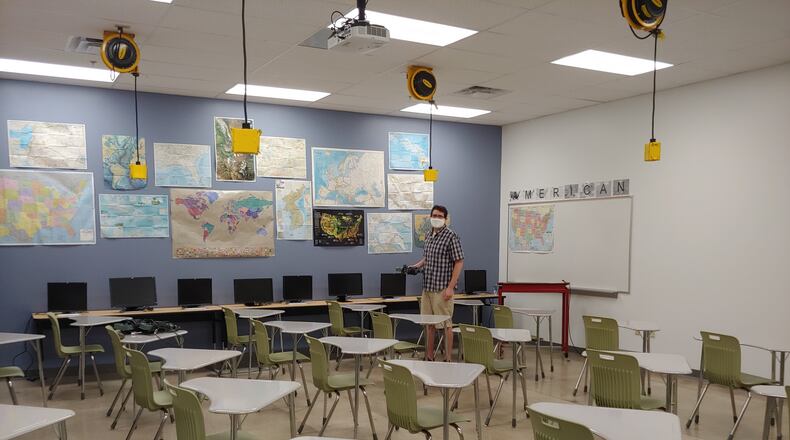So how can parents prepare their children for a bumpy ride? Experts say it’s an ideal time to teach youngsters resilience and flexibility. Learning to roll with the punches is a life lesson that will hold them in good stead.
Demmitt believes one of the best things a parent can do when there are a lot of changes is to make sure there’s stability to counteract the ups-and-downs.
Credit: CONTRIBUTED
Credit: CONTRIBUTED
“You can help your child see that although a lot has changed in education, it’s not everything,” he advises. “A classroom is a classroom whether it’s online, Zoom or face-to-face. There may be a move to computers or students may have to wear a face mask into the classroom, or recess may be different this year. Remind them of what will stay the same. They will still have to focus and pay attention, there will still be homework, they may be going to the same school building. They can still have a daily schedule; they can still see and interact in some way with their friends.”
Parent-child relationships
One of the best predictors for a child’s ability to bounce back, Demmitt says, is a strong relationship with a parent or parents. “Parents should make sure they continue to talk to their child about changes and — more important — continue to listen to their children when they express apprehension, fears, concerns.” He says it’s not necessary to change their minds, it’s just important for them to know they are being heard.
Demmitt cautions parents to keep adult issues between themselves. “If you have to vent, be aware of who else might be hearing what you’re saying.”
A sense of humor always comes in handy. “When our own kids were younger our adage was always ‘if you can laugh at it, you can live with it’,” he says. He cites mask mandates as an example. “You can let them know wearing a mask is serious, but you can still make a joke out of it. You can joke about how it looks when you put it on.”
Part of UD‘s Marianist philosophy, Demmitt explains, is that new times require new methods. It’s a lesson you can teach your youngsters. “That’s what life is all about; things change,” he says. “Nothing really good and nothing really bad lasts forever. Good and bad things come to an end. It’s important to acknowledge that with COVID. When you have a cold, it may last for 10 days, but it will run its course. This virus will last longer, but it will end, too.”
Parents can reassure their children that although they may be having school from home this semester, they will be going back to school some day and if it’s not this year, it will be next year. “The world has been through these kinds of things before,” he says.
Credit: CONTRIBUTED
Credit: CONTRIBUTED
Creative ways to socialize
Mary Beth DeWitt, who heads the division of psychology at Dayton Children’s, says resiliency develops through an interaction of a variety of factors that include spending time with supported and trusted others and engaging in positive peer relations.
She says parents have to be creative in finding ways for their kids to stay connected and still honor health guidelines. “Parents can consider play dates outdoors, which can allow for physical presence, but still social distancing and masking,” she suggests, adding that moms and dads should be especially mindful of helping kids who seem to enjoy the isolation. “Peer relations serve as a positive protective factor against stress, and help children develop social skills. These children should also be encouraged to reach out and be connected to others.”
Dr. Sherman Alter, chief, division of infectious disease at Dayton Children’s, advises families who are getting together to practice physical distancing, mask usage, attention to hand hygiene and daily screening of all attendees for symptoms of coronavirus infection — cough, fever, shortness of breath, etc. “All of these children and their supervising/teaching adults are still at risk of acquisition of infection including acquisition from asymptomatic infection,” he says.
A teacher’s advice
Nick Pant, a ninth-grade history teacher at The Dayton Regional STEM school, says his school prides itself on preparing students to solve problems that may not yet exist.
“Right now, the pandemic is offering us a variety of problems to consider solving,” he says. “Our core qualities of collaboration, communication, creativity, inquiry and persistence will hopefully give students the confidence to remain resilient. We also encourage our students to self-advocate. This doesn’t only concern academic struggles, but applies to keeping a growth mindset in the face of adversity.”
Credit: CONTRIBUTED
Credit: CONTRIBUTED
Pant says one of the ways he’s planning to offer students a chance to socialize and work together is through virtual breakout rooms.
“I’m sure some things from the pandemic will stick around once things progress,” he says. “Learning how to collaborate through platforms like Zoom may be a valuable skill that students will apply in the future. It’s also a new way to start the school year, so hopefully after the first day, the disappointment is replaced with intrigue.”
Instead of being together for initial team-building activities this year, Pant says students may feel isolated in front of a computer screen. “I plan to slow things down and have more ‘show and tell’ opportunities to be deliberate in the time needed to build social skills.”
TIPS FOR PARENTS
Anita Craighead, a classroom coach for Preschool Promise, spent 10 years as a public school teacher and 15 years coaching and training other teachers on best classroom practices. Here are her tips on promoting resilience and socialization.
Resilience and flexibility
- Connection is key. Spend time with your child daily. Have time where electronics (and other distractions) are put away. Include eye contact, touch and playfulness as well. Play games together, talk, do art, play a hand-clapping game, etc.
- Create routines and rituals that you do with your child regularly. Have a special song you sing together at bedtime, eat dinner together, etc.
- Talk about feelings with your child. If they are old enough, have them identify where they feel each feeling in their body (in their chest, tummy, hands, etc.). Help them name the feeling and breathe to help calm down before trying to solve the underlying problem.
- Set up a place in your house where your children can go when they feel upset. Include soft pillows and things that they find calming. When they have strong feelings, they can choose to visit this place to help them relax.
- For parts of your day or routines that are hard, provide picture schedules and visuals to help them see what is coming and what is expected.
- When you know something will be different or there is a change in routine, talk about it ahead of time so your child can start to prepare for it.
- When starting back to school, talk about what is going to happen and include pictures. For example, if your child is going back to school, discuss what social distancing and wearing masks might look like when they get there. Then, practice what that might look like to help calm any fears.
Socialization
- (Remember to follow the guidelines set forth by the local, state and federal governing agencies along with those from health professionals.)
- Help your child keep in touch with friends and family members via physically distant in-person meetings, video calls or phone calls.
- Look for and enroll in a Scout program in your area that is planning virtual activities your child can participate in.
- If there is a family member or neighbor you have chosen not to socially distance from, schedule regular meetings with them.
- Set up a virtual play date with a friend via a video call. If you plan ahead, maybe both children could have the same toy or activity to do as they interact over the video.
- Look for online play groups.
- Sign up for socially distant, small group activities (at parks, gymnastics facilities, etc.).
- Set up a socially distant play date outside with a friend. They can play with similar toys and talk while remaining physically distant.
About the Author




